If you’ve found a 1939 penny, you might be curious about whether it holds any value — or maybe you’re simply intrigued by its background. Either way, you’re in the right place!
In this guide, we’ll take a close look at the 1939 Wheat Penny value. We’ll explore how its color and condition affect its worth, and we’ll dive into its history and design as well.
Ready? Let’s break it down!
1939 Wheat Penny Value Chart
| Mint Mark | MS62 | MS65 | MS67 | MS68 |
|---|---|---|---|---|
| 1939 (P) No Mint Mark | $3 | $24 | $160 | $14,000 |
| 1939 D | $8 | $26 | $150 | $10,500 |
| 1939 S | $6 | $24 | $150 | $11,500 |
Proof 1939 (P) Penny Value
| Grade | Brown | Red & Brown | Red | Cameo |
|---|---|---|---|---|
| PR60 | $30 | $32 | $45 | n/a |
| PR63 | $50 | $75 | $100 | $250 |
| PR65 | $90 | $110 | $215 | $2,650 |
| PR67 | n/a | n/a | $1,650 | n/a |
📝 Note: These values apply to coins graded Red (RD) unless stated otherwise.
History of the 1939 Wheat Penny
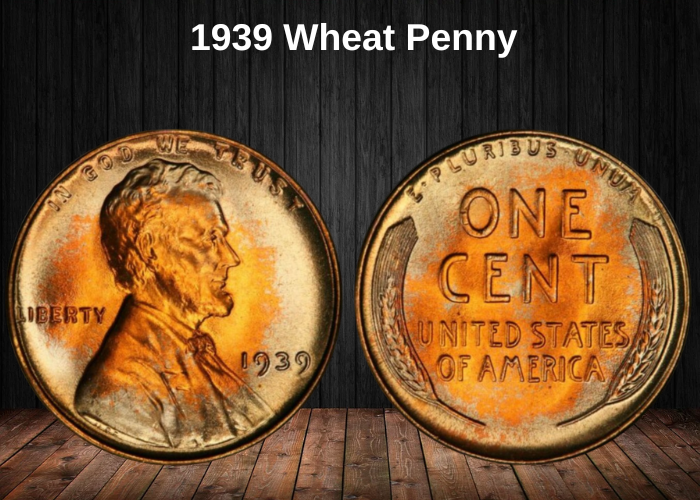
The 1939 penny closely resembles modern cents in many ways. It’s part of the Lincoln penny series, named for the former president Abraham Lincoln, whose portrait appears on the obverse.
However, the reverse design sets it apart from today’s coins. It features two ears of durum wheat, which is why these coins are also known as Wheat pennies.
The Lincoln cent was first introduced in 1909, marking the first time a real person appeared on a U.S. coin. Prior to this, such representations were avoided due to concerns of mimicking monarchies.
But 1909 marked 100 years since Lincoln’s birth (he was born in 1809 and assassinated in 1865). As the anniversary approached, public opinion strongly favored commemorating him with a coin.
The Mint enlisted Victor David Brenner to design the coin in January 1909, and just seven months later, the first Lincoln pennies were released.
Interestingly, those initial coins were unsigned. Brenner had wanted to sign Lincoln’s portrait but was advised against it. He instead placed his initials on the reverse. When the coins debuted, however, critics argued the initials were too prominent—amounting to self-promotion. This caused such a stir that production was briefly halted.
Rather than redesign the coin with smaller initials, the Mint chose to remove them entirely. But in 1918, Brenner’s initials were restored, this time placed subtly at the bottom of Lincoln’s portrait on the obverse—where they remain to this day.
The Wheat penny design lasted until 1958. In 1959, the reverse was redesigned to feature the Lincoln Memorial, commemorating the 150th anniversary of Lincoln’s birth.
Features of the 1939 Wheat Penny
The Obverse of the 1939 Penny

The obverse of the 1939 penny is very similar to today’s modern cent. It features the same portrait of Abraham Lincoln, originally designed by Latvian-American artist Victor David Brenner for the first Lincoln cents.
If you look closely at Lincoln’s shoulder, you’ll spot Brenner’s initials “V.D.B.” subtly engraved at the bottom of the bust.
Above Lincoln’s head is the motto “IN GOD WE TRUST”, which curves along the upper edge of the coin.
The word “LIBERTY” is located to the left of the portrait, while the date “1939” appears on the lower right side.
If your penny was minted in Denver or San Francisco, there will be a mint mark just below the date.
- A small “D” indicates Denver.
- An “S” signifies San Francisco.
- If there’s no mint mark, the coin was produced at the Philadelphia Mint.
The Reverse of the 1939 Penny
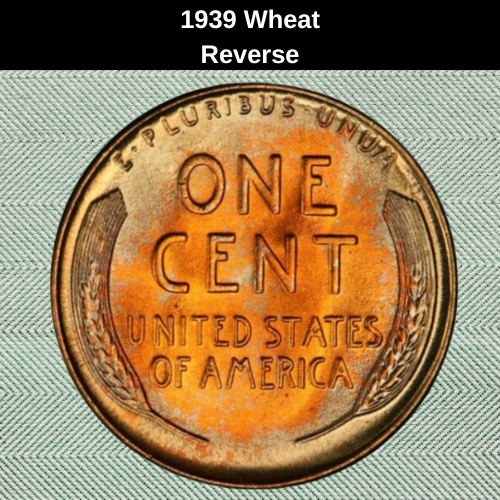
The reverse of the 1939 penny features the same wheat ears design found on the earliest Lincoln cents. Like the obverse, it was designed by Victor David Brenner.
This design was actually Brenner’s second proposal—his first idea, a tree branch, was rejected because it looked too similar to contemporary French coins.
The two stylized and symmetrical wheat ears frame the coin from both sides. Between them is the large denomination “ONE CENT”, which serves as the focal point of the reverse. Below that, in smaller text, is the country name “UNITED STATES OF AMERICA.”
At the top edge of the coin, arching along its curve, is the Latin motto “E PLURIBUS UNUM,” which translates to “From the many, one.” This reflects the formation of the United States as a union of individual states.
Other Features of the 1939 Penny
The 1939 penny weighs 3.11 grams and measures 19 millimeters across. It’s made of bronze – 95% copper, and 5% tin and zinc. That high copper content means individual coins change color as they age and are handled.
When copper is new, it appears red. But as it reacts with oxygen in the air, its color shifts to brown. Because of this natural aging process, brown pennies are far more common than red ones. That’s why color plays a big role in the value of 1939 pennies.
Coin grading agencies classify pennies into three color categories:
- Red – if 95% or more of the surface remains red
- Brown – if 95% or more of the surface is brown
- Red and Brown – for anything in between
1939 Wheat Penny Grading
| # | Grade |
|---|---|
| 1 | Basal State-1 |
| 2 | Fair |
| 3 | Very Fair |
| 4, 5, 6 | Good |
| 7, 8, 10 | Very Good |
| 12, 15 | Fine |
| 20, 30 | Very Fine |
| 40 | Extremely Fine |
| 50 | About Uncirculated |
| 60 | Mint State |
| 65 | Mint State |
| 70 | Mint State |
Please check our grading guides to know your coin scale.
It’s the necessary step to know the exact value of your coin.
1939 Wheat Penny Value Guides
1939 No Mint Mark Penny Value
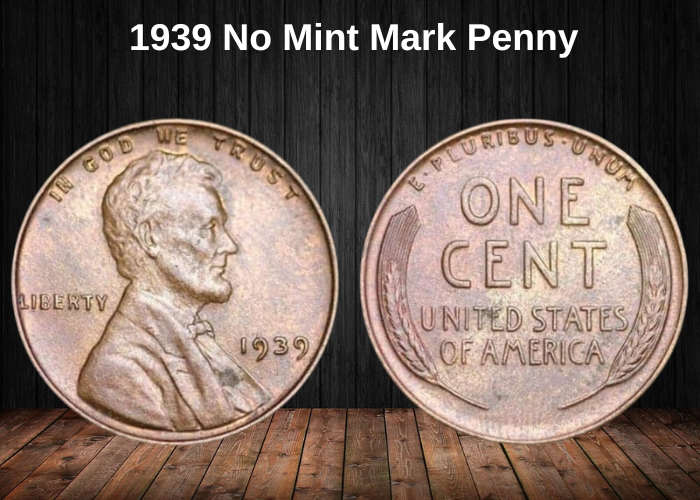
If your 1939 penny was minted in Philadelphia, you can identify it by the lack of a mint mark. Check just below the date—if there’s no small letter, it means the coin came from Philadelphia.
More than 316 million of these pennies were produced, making them far more common than those from Denver or San Francisco. Coins that are brown or red-brown and have been in circulation generally aren’t worth more than face value, unless they have a noteworthy mint error.
Red coins in uncirculated condition, however, tend to be more valuable. Depending on their grade, their value can range from just a few dollars to several thousand.
That’s why grading is so important. Independent grading companies like NGC and PCGS evaluate coins using a scale from 1 to 70.
Coins that haven’t been circulated are graded MS60 and above. If they’re MS65 or higher, they’re known as gems. A coin graded MS70 is considered to be in perfect condition.
A red 1939 Philadelphia penny graded MS62 is typically worth around $3. Even a gem-quality MS65 example is fairly affordable, usually around $24.
At MS67, the number of available coins drops off significantly, causing prices to rise. A coin graded MS66+ is worth about $46, but jumping just half a grade higher to MS67 increases the value to around $165. An MS67+ can fetch as much as $475.
At the very top are six coins graded MS68 by PCGS—each valued at an impressive $14,000.
1939 D Penny Value
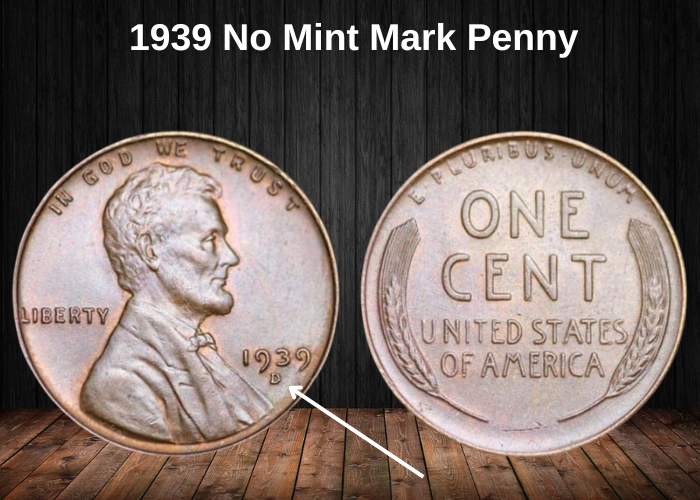
If you spot a small “D” beneath the date on your 1939 penny, it means the coin was struck at the Denver Mint. That year, a little over 15 million of these pennies were produced. According to PCGS estimates, around 10,000 red examples have survived to this day.
For most grades, values are quite similar to the 1939 Philadelphia pennies. Brown and red-brown coins typically carry a value of just one cent. And even red coins in lower mint state grades (up to MS62) can still be found for under $10.
The real difference in value shows up when it comes to coins in top-tier condition. PCGS has graded 65 examples of the 1939-D penny at MS67+, placing a value of about $600 on each.
That price has come down a bit over time but is still notably higher than the $475 value assigned to Philadelphia pennies of the same grade—even though only 56 Philly coins have been certified at MS67+.
As with the Philadelphia mint, the highest grade known for a 1939-D penny is MS68. So far, ten Denver coins have received this grade from PCGS—four more than from Philadelphia.
That higher availability helps explain the slightly lower value. While still impressive, a 1939-D MS68 red penny is valued at around $10,500 each.
1939 S Penny Value
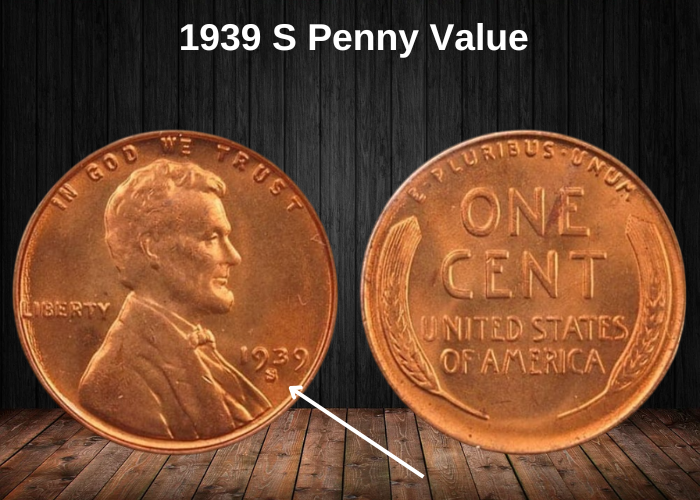
In 1939, the San Francisco Mint struck just over 52 million pennies, which can be identified by the “S” mintmark located beneath the date on the obverse.
Today, it’s estimated that about 14,000 red examples still survive—roughly the same number as red and brown coins. In contrast, brown coins are far more common, with over 5 million thought to remain. Because of that high number, brown 1939-S pennies usually don’t carry any premium unless they feature a notable Mint error.
For coins in mint state, values start around $3 to $4 for red and brown specimens graded MS60 to MS62+. Red coins in the same range are worth slightly more—between $4 and $8.
The top quality for red and brown coins is MS67+, with a value of around $250. A red coin at that grade can fetch up to $500.
As for the best of the best, just two red 1939-S pennies have been graded MS68 by PCGS, and they’re valued at a hefty $11,500 each.
1939 (P) Proof Penny Value
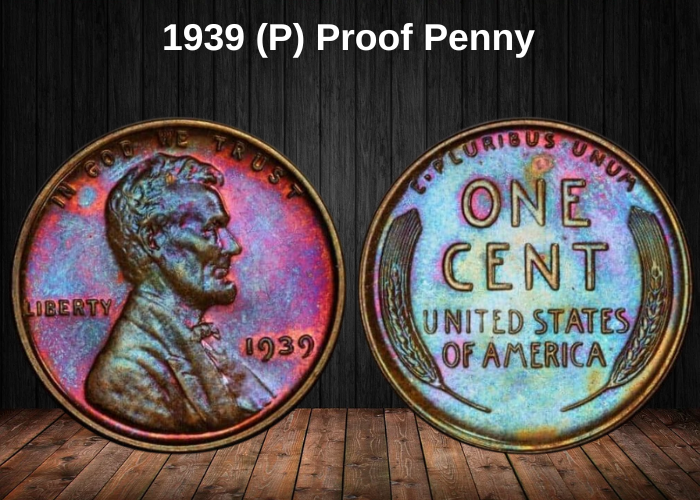
In addition to the business strikes, the Philadelphia Mint also produced 13,520 proof pennies in 1939, specifically for collectors. Like regular coins, these are categorized into three standard color designations—brown, red and brown, and red—but proof coins also have a fourth category: cameo.
Cameo proofs are distinguished by their attractive contrast between frosted design elements and mirrored, reflective fields (the flat background of the coin).
Despite their age, even brown proofs can hold decent value. Since proof coins were never intended for circulation, the lowest grade you’ll typically encounter is PR60. A brown 1939 proof penny at that grade is worth about $30, while a PR65 example is valued around $90.
Red and brown proofs range in value from $32 (PR60) to $225 (PR66).
As usual, red proofs command the highest premiums, particularly at higher grades. A PR60 red proof is valued around $45, rising to $325 at PR66+. For those seeking the best of the best, five examples have been certified PR67+ red by PCGS, each worth approximately $5,750.
So far, only one cameo proof 1939 penny has been certified by the PCGS—a PR65, estimated at $2,650.
Rare 1939 Wheat Penny Errors List
1939 (P) Penny, Double Die Obverse
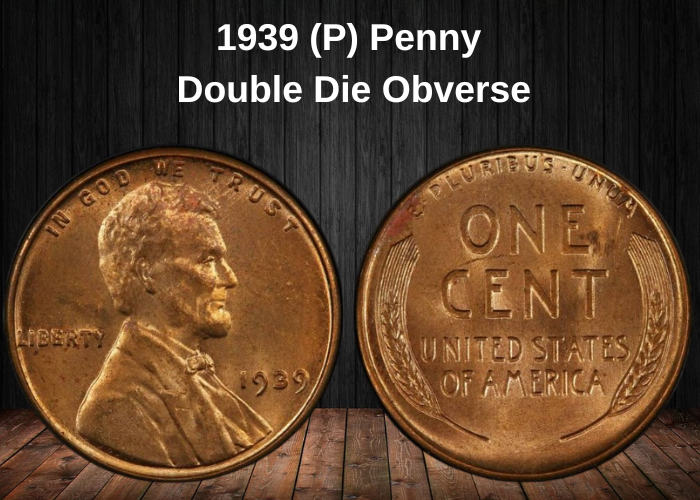
When there’s an error during the creation of a die, that mistake gets passed on to every coin it strikes.
That’s exactly what happens with doubled die errors, which occur when there’s a slight movement during the process of transferring the design from the hub to the die. This results in noticeable doubling on parts of the image. If it affects the obverse die, it’s referred to as a doubled die obverse.
One such error occurred on a die used for striking some 1939 Philadelphia pennies. Coins struck with this faulty die show doubling on the “1” and the first “9” of the date, as well as on parts of Lincoln’s bust.
As with most coins, value depends on both color and condition. For example:
- A brown 1939 doubled die penny graded MS63 sold at auction in 2013 for $118.
- A red and brown MS64 example brought $242 the following year.
- The most recent public sale of a red MS65 coin occurred in 2014, fetching an impressive $715.
1939 (P) Penny, Struck Off-Center
Occasionally, the planchet (the blank metal disc used to make coins) and the die aren’t properly aligned, resulting in an off-center strike. The value of these errors depends on how dramatic the misalignment is, as well as the condition of the coin.
For example, a 1939 penny struck in Philadelphia had a minor off-center error—about 10% off-center. Despite the slight misalignment, the coin was still considered an interesting anomaly. It was graded MS62 red and brown by the PCGS and sold at auction for $125.
Where to sell your penny?
Now that you know the value of your penny, you might be wondering where to sell it. Don’t worry: here’s a guide to some of the best online platforms where you can easily sell your coins, along with their advantages and disadvantages.
Discover the best platforms for selling coins online (pros and cons).
FAQs
1. What historical and economic factors influenced the production of the 1939 Wheat Penny?
The 1939 Wheat Penny was struck during a pivotal time just before the U.S. entered World War II. The country was emerging from the Great Depression, and although the economy was improving, international tensions were growing. These factors influenced the continued use of copper in cent production, even as other nations began to conserve metals for war. This coin represents one of the final years before major changes in coin composition (like the 1943 steel cent) due to wartime resource needs.
2. Why is the 1939 Wheat Penny considered common in circulated condition but rare in high mint state?
Although hundreds of millions of 1939 cents were minted across all three U.S. mints (Philadelphia, Denver, and San Francisco), most entered circulation immediately. As a result, well-preserved, high-grade examples are relatively rare today. In particular, coins graded MS66 or higher with full red (RD) coloration are difficult to find, making them highly valuable to collectors aiming for pristine sets.
3. How do the 1939-D and 1939-S Wheat Pennies differ in terms of strike quality and market value?
The 1939-D (Denver) and 1939-S (San Francisco) pennies tend to have slightly softer strikes compared to the Philadelphia issue. This makes finding sharply struck specimens more difficult. The 1939-S, with a mintage of 52,070,000, is scarcer than the 1939-D (15,160,000), and in high-grade, red-colored examples, the 1939-S often commands higher premiums. Strike sharpness, luster, and eye appeal can significantly affect value between mint marks.
4. What types of mint errors or varieties are known for the 1939 Wheat Penny, and how do they impact value?
While the 1939 Wheat Penny doesn’t have any famous major doubled die errors, it is known to have several collectible varieties, such as:
- Re-punched Mint Marks (RPMs) on 1939-D and 1939-S coins.
- Die cracks, cuds, and lamination errors.
- Off-center strikes and broadstrikes.
These errors, especially when certified and in high grades, can fetch significant premiums. A well-centered 1939-D RPM in MS65 RD can be worth over $150–300, depending on market demand and eye appeal.
5. How do color designations (Red, Red-Brown, Brown) influence the value of the 1939 Wheat Penny?
Color is crucial in copper coin valuation. The Red (RD) designation is given to coins with at least 95% of their original mint red color, making them more desirable. For 1939 pennies:
- Brown (BN): Common, even in high grade, with lower market value.
- Red-Brown (RB): Mid-tier in desirability and price.
- Red (RD): Most valuable, especially in grades MS65 and higher.
For example, a 1939-S MS66 BN might sell for around $40–60, while a 1939-S MS66 RD can command $150–250+, depending on luster and strike quality.
6. How does the 1939 Wheat Penny compare to surrounding years in terms of long-term investment potential?
Compared to earlier Wheat cents from the 1910s and 1920s, the 1939 Wheat Penny is more common. However, in the context of late 1930s to early 1940s issues, it offers moderate investment appeal. Its value steadily increases in MS65 RD and above, and the Denver and San Francisco mint issues have gained collector interest due to their comparative scarcity in high grades. For long-term investment, focusing on graded, red-designated coins from 1939-D and 1939-S can be a smart move.
7. Why is the 1939 Wheat Penny an essential part of a complete Lincoln cent collection?
Even though it’s not one of the rarest years, the 1939 Wheat Penny is historically and visually significant. It completes a bridge between the economically turbulent 1930s and the upcoming wartime changes in U.S. coinage. A full Lincoln cent collection demands high-quality representatives from each year and mint mark, and acquiring all three 1939 coins (P, D, and S) in MS65 RD or better can be both a challenge and a reward for serious collectors.



















































